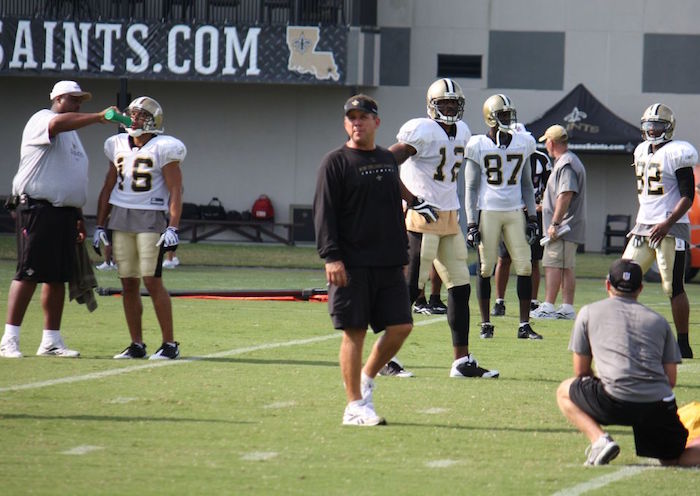
Sean Payton’s bland play-calling landed him on the week 1 sinners list.Image via Scott on Flickr, used under this Creative Commons License.
Hello, folks. Saints and Sinners is a series that analyzes each facet of the offense and defense from the weekend. As usual, I’ll start with the offense, then grade how the passing offense and rushing offense performed. I will then give you a few “Saints” and “Sinners for both sides of the football. The “Saints” are the particular players that deserve praise for their performances. The “Sinners” are players that struggled the most. We’ll discuss what they struggled with and whether or not it’s something I believe can be fixed.
Over the past four years of writing for Saints247, these have become my favorite posts to write, and I want to urge you guys to add your comments below and let me know what you think. Time to get going!
Saints Offensive Grades
Passing: C
Drew Brees and the rest of the passing attack were very much average. There were both positives and negatives. Some parts of the attack looked great, but some were also concerning. I’m a “bad news first” kind of guy, so let’s knock out the negatives first. Although I largely believe that play-calling played a big role in this, the down field passing attack was nearly non-existent. If you look at Brees’ stats, you see 355 yards and think, “Man, he threw all over the Cardinals.” The kicker is that 154 of those yards came out of the backfield. The game consisted of a lot of screens and check downs. Obviously they worked to an extent, due to the amount of receiving yards that Mark Ingram and Khiry Robinson put up, but it was the crucial situations that hurt the Saints on Sunday. The screen plays were working for about three quarters, but Arizona finally caught on and it seemed as if Sean Payton had no answer. A lot of these issues occurred in the red-zone, leading to a 25% touchdown conversion percentage out of four trips down there. You have to credit the Cardinals for coming in with a good game plan and being able to stop the Saints when they did attempt down field passes, but Payton and Brees are going to have to do better moving forward.
Rushing: F
I knew the rushing game struggled, but I didn’t realize just how bad it was until I looked at the stats. Ingram and Robinson averaged 2.7 and 2.4 yards per carry, respectively. The two only got seventeen carries combined, which is odd considering the Saints controlled the clock, holding the ball for seven more minutes than the Cardinals. The two, along with Austin Johnson, did combine for fifteen receptions, which goes to show you what I was talking about with the passing attack. Another thing to note was that the Saints offense had a lot of penalties on first and second down, which was setting up second and third and long situations throughout the game, making it harder to commit to the run on the drive. The offensive line didn’t really play terrible, it just appeared as if the entire game plan was underwhelming.
Offensive Saints and Sinners
The Saints
Mark Ingram: Ingram may have struggled running the ball, but he put up by far his best game catching the ball out of the backfield. Hauling in 8 receptions for 98 yards, Ingram made the most out of every screen or check down that Brees threw his way. I was very high on him and his improved ability to catch passes this year, but even that was a surprise. Obviously C.J. Spiller will play a big role in the passing game when he’s healthy, but it’s nice to know that the Saints are not limited in play calling when Ingram is on the field.
Brandon Coleman: It wasn’t a monster game by any means, but Coleman made his first NFL game appear as if he’s been playing in the league for a few years. He had 4 receptions for 41 yards and a touchdown and was targeted by Brees on three other throws, as well. His touchdown was the highlight of his day and not just because it was a touchdown. He first made the catch and spun out of an immediate tackle, then kept his balance long enough to tip-toe down the side line and dive for the pylon with a defender bearing down. He somehow kept his body off of the ground for just long enough to extend the football and cross the plain of the goal line. I expected Coleman to play a large role in the offense this year, so it was great to see the effort he put up.
The Sinners
Marques Colston: The veteran that we’ve always known to be Mr. Reliable was anything but that in the fourth quarter of Sunday’s game. He dropped two key passes that could have helped extend the Saints drive. Thankfully, I don’t believe it was anything other than just a bad game for Colston and I fully expect him to come up big throughout the season.
Sean Payton: I’ve made it no secret that I really did not like the game plan or play calling on Sunday, thus Payton ending up here. For a coach that has built his NFL resume on a dynamic offense that can throw just about anything out there, the offensive attack seemed bland.
Saints Defensive Grades
Passing: C
Just like the passing offense, the defense finished right at mediocre with both positives and negatives. The big negative was the lack of pass rush for most of the game. The Saints did not sack Carson Palmer one time and barely seemed to bother him on other occasions. Although there were quite a few penalties in the secondary, they were committed with the ball nearing the receiver, instead of early in coverage and grabbing hold because the defender got beat. I can live with that, because it means they were playing aggressive. They were mostly in position and either didn’t turn their head or put their hands on the receiver a little too early. It’s a lot easier to watch film and be coached up on how to fix mistakes like that, rather than having to figure out why a cornerback is allowing separation from his receiver just three yards into the route.
Rushing: D
Again, like the rushing offense, the rushing defense struggled. Starting running back Andre Ellington averaged 5.8 yards per carry on his 12 rushes for 69 yards, including his one yard goal line touchdown run. The front four did a bad job of blocking up holes for him to run through, letting Ellington get to the second level on a consistent basis. Players like Stephone Anthony are more than capable of producing, but when every offensive lineman is easily winning their one-on-one battle, there’s going to be two or three extra blockers that don’t have to double team anyone and can get to that second level to block linebackers and safeties.
Defensive Saints and Sinners
The Saints
Delvin Breaux: I know Breaux was called for defensive holding on multiple occasions, but like I said earlier, he was in great position throughout the game and simply over-estimated the amount of contact he could make without getting flagged by the officials. The CFL is much more lenient in that aspect, which explains why he was called so often. He had even talked about learning what he can and can’t get away with in regards to contact back during training camp, so this was no surprise. Once he figures it out, he’ll be just fine considering he was at his receivers hip throughout the game.
Stephone Anthony: He wasn’t able to make quite as many plays as we’d have liked, but he did flash his ability a few times. He led the team with two tackles for a loss, flying through the gap and drilling the running back with authority. I have beamed in excitement for him in just about every piece I’ve written to start the year and this only solidified my excitement.
Hau’oli Kikaha: This is sort of an honorable mention, but I believe he deserves recognition for his great play when he forced the Ellington fumble. He chased from behind in pursuit and swiped at the ball as he was going for the tackle, knocking it right out of Ellington’s arm. He didn’t do a whole lot other than that, but it was a turnover forced that always deserves praise.
The Sinners
Defensive line: I can’t really pinpoint one particular player, because they all struggled. Whether it was against the pass or the run, they didn’t perform. They allowed Palmer to have a lot of time to throw and the Arizona offensive line to open up huge holes for Ellington. When you have a banged up secondary as the Saints do, the front four has to play very well to help cover up the deficiencies. Instead, the line was a deficiency itself.
Rob Ryan: Just like with Sean Payton, I believed that the defensive game plan was also poor. Two key struggles stood out to me. First, with the front four struggling to create much of a pass rush, Ryan rarely sent extra men on blitz. Obviously blitzing leaves the coverage susceptible with fewer defenders, but what’s the difference if the quarterback is going to have all day to scan the field and find one little hole to throw the ball? Any starting quarterback in the NFL will kill you if he has all day to throw, especially an accurate one like Palmer. The other problem that I noticed was defenders playing way too soft in coverage off of the snap. The Cardinals had multiple 2nd or 3rd and 5 situations where Palmer took the snap, dropped back, and immediately threw the ball to a wide open receiver a yard beyond the first down marker, while the Saints defender was another four yards deep. Between the lack of blitzing and the soft zone coverage, it almost seemed as if Ryan’s entire game plan revolved completely around not giving up a big play by any means. Arizona has some good receivers, but I don’t quite understand playing like that against a team without a receiver like Calvin Johnson, Julio Jones, or Dez Bryant.
That’ll do it for today and for our coverage of Week 1. We now move on to the Tampa Bay Buccaneers, as they come to New Orleans for a match-up with the Saints at noon on Sunday. Keep an eye out for the offensive preview to come out within the next couple days and as always, thanks for stopping by. Don’t forget to drop a comment and let me know what you think! See y’all soon.
Who Dat?!



Hi David and S fans. I think your grading and analysis of week one is pretty much dead on. I’m glad you did a summary of the stats because it agrees with what I was thinking too. The passing yardage pretty much came out of the backfield which is mostly equivalent to a run. So that’s what I was thinking that Sean Payton was trying to “replace” the handoff runs so they can get around the line interference. But defenses are going to catch onto that as Arizona did and probably should have a little sooner than the fourth quarter. The red zone was definitely a problem and the penalties which put us in make up yardage situations that the Saints of the past used to be able to overcome. It’s pretty obvious Marques Colston is not the same player he used to be from all of the drops he had last year and the ones he has so far this season. I heard from a good source he said himself that after he was injured, he tends to hear footsteps while catching the ball. I was hoping Coleman could step up to his previous level and catch things like over the shoulder and the proverbial thrown into coverage situations since he has the same physique which looks promising.
Defensively, I think you are right on about the cushion coverage. If the defensive line could step it up and get good rushes, it would be easier for the secondary to play tight I think it would help if they could disguise the coverages a little better such as showing different looks before the ball is snapped too. Especially on blitzes. I forgot which team it was in the preseason when the call was an all out on fourth and twenty something. Even though it was a bad call, I liked the gamble and it should have worked but the Saints executed poorly. A QB shouldn’t be able to step out of the rush and throw the ball as far as he did. Also if I remember correctly, I saw a blown coverage or mis-tackle in the secondary that would have been a stop before the first down marker. Yeah David, I like an aggressive defence too and I hope the Saints will keep practicing it. Gotta play like that if we want to win games. Breax does look promising. I had to laugh at the first penalty called on him. He pretty much tackled the guy. I thought one of the interference calls against him was bad. There was a little contact with one of each player’s hand while fighting for position and the call could have gone either way but should have been left alone. I think the refs have too much play when it comes to calls like that.
While I’m here, I wanted to ask something off the topic, Does anyone know if there was any proof of bonuses paid out on the Gregg Williams bounty scheme? Just wanted to know if it was just the video of him talking about it that cemented his fate and was it really carried out?
Hey, Paul. Thanks a lot for the comment. We truly appreciate it. Very solid points that you added in. I agree with Breaux’s penalties. There were two that were extremely obvious and one that was kind of ticky-tack, as they say. There was also one on Damian Swann where the receiver reached out first to push Swann away, so Swann swiped his arm away and got called for interference. It was a very poor officiated game, in my opinion. That’s typical in the early weeks, though. The officials are still getting in to the swing of things, too.
As for Gregg Williams, as far as I know, I don’t know if they had any proof of payments to players, but that would have all been in cash, because any paper trail of extra payments to players from a coach could also be penalized for tampering, in accordance with the salary cap. I do know that they had audio of him talking about bounties, but I’m not sure about video. They had tons of evidence, because the Saints cooperated with them instead of fighting and let them seize computers, which is where they found a lot. What’s disappointing, is that the reason Sean Payton couldn’t do anything about his suspension is because he isn’t a part of the coaches association that is in place. Just like the NFLPA, the coaches association will fight the NFL on suspensions and fines, so he could’ve had help. He and Belichick are the only two head coaches not in it. He was also told that if he cooperated and just took his year suspension, it would definitely be no more than a year and not possibly longer. All in all, it was certainly a very unfortunate situation that costed the Saints organization a vital year of Drew Brees’ prime.
Hi David, thanks for the follow up. I was reading stuff about other opposing team players and as Ronnie Lott said that bounties are pretty common in the NFL and also said for him it started as “ataboys” when you got a good play or hit way back in high school. He said his approach is not intentionally trying to put the player out but does want to get a good hit or play. Also said the Saints just got their hand caught in the cookie jar. I thought they had a video of him too but for sure audio. Do you know how they got tipped off and got a hold of the audio or video? I see that Williams also had bounties on other teams he coached such as Buffalo. Funny how it all came down on the Saints. Why weren’t other teams investigated? I think Roger that was out to get us or a few were on the commission. Thanks for going off the topic for me. I’ll be looking forward for comments about TB.